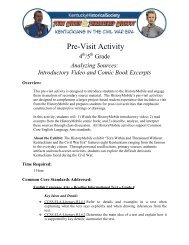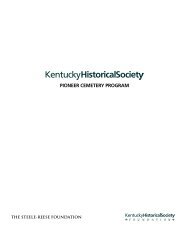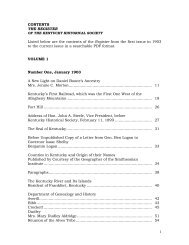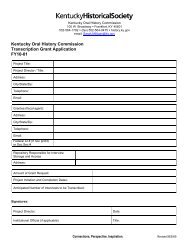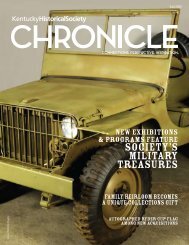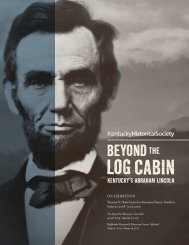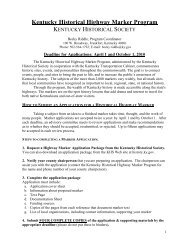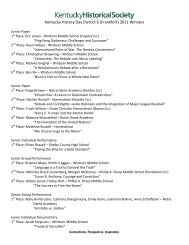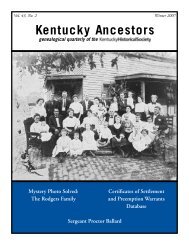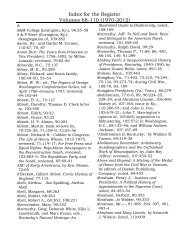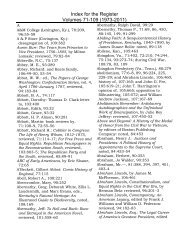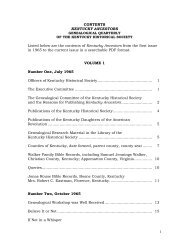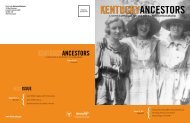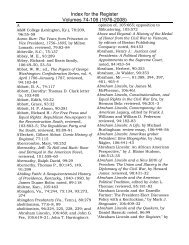Kentucky Ancestors, Volume 46, Number 3 - Kentucky Historical ...
Kentucky Ancestors, Volume 46, Number 3 - Kentucky Historical ...
Kentucky Ancestors, Volume 46, Number 3 - Kentucky Historical ...
You also want an ePaper? Increase the reach of your titles
YUMPU automatically turns print PDFs into web optimized ePapers that Google loves.
Ephraim Kibbey’s Company of Scouts and Spies<br />
from Hamilton County also showed “the above<br />
company was called into the service as a substitute<br />
for any deficiency in the number of volunteers from<br />
<strong>Kentucky</strong>.” 11<br />
Some of the caption cards contain general<br />
statements about company pay abstracted from the<br />
original rolls. The cards for Maj. William Price’s<br />
Battalion, <strong>Kentucky</strong> Mounted Volunteers, include<br />
an endorsement from battalion paymaster, Samuel<br />
Postlethwait, which validated the payroll submitted<br />
to the War Department for services rendered from<br />
10 July to 21 October 1794. Postlethwait certified<br />
receipt of $823.16 from Paymaster Thomas Love,<br />
“for the subsistence of the officers of Maj. Price’s<br />
Battalion.” Additional endorsements verified payroll<br />
disbursements to the troops as well, including Capt.<br />
Anthony Bartlett’s Company ($7087.86); Capt. John<br />
Francisco’s Company ($7039.61); Capt. George<br />
Frazer’s Company ($6668.35); Capt. William Lewis’s<br />
Company ($10,012.11); and Capt. John Arnold’s<br />
Company of Spies ($8378.36). Brevet Maj. E.W.W.<br />
Butler of the Fourth Sub-Legion of the United States,<br />
appointed to inspect volunteers, also endorsed the<br />
battalion’s muster rolls as a true record of the men he<br />
mustered out of service on 21 October 1794. 12<br />
The original muster rolls—the documents upon<br />
which the carded service records were based—still<br />
exist for many volunteer militia organizations. The<br />
rolls provide information about troops actually<br />
present at monthly or special reviews. During such<br />
inspections, officers (usually an inspector general)<br />
noted the number of troops present, their condition,<br />
and the status of their arms and equipment. Special<br />
notations include the names of company officers, and<br />
the number of soldiers absent, including those sick<br />
or under arrest. Muster-for-payrolls were used for<br />
monthly and quarterly pay periods, and contain more<br />
detailed information such as the names of all privates<br />
receiving pay, their rank, date and place of enlistment,<br />
date of muster into service, and the date and amount<br />
of last pay received. Notations regarding desertions<br />
and deaths also appear. Muster-out rolls, created just<br />
before a regiment’s final disbandment, usually contain<br />
the most complete information, including aggregate<br />
lists of all members associated with the organization<br />
during its term of service. 13<br />
130 | <strong>Kentucky</strong> <strong>Ancestors</strong><br />
Muster rolls relating to early Indian campaigns<br />
are also located in RG 94, with rolls for <strong>Kentucky</strong><br />
militia from 1791–94 in the series “Muster Rolls<br />
of Volunteer Organizations: War with Northwest<br />
Indians, 1790–95” (Entry 54). Records for <strong>Kentucky</strong><br />
units called out during 1806–07 are also included, as<br />
well as rosters for federal organizations (U.S. Levies<br />
and Rangers) and other state militias, including<br />
Georgia, Ohio, Pennsylvania, Virginia, and the<br />
Territory South of the Ohio. This series sometimes<br />
contains assorted papers relating to particular<br />
companies, including orders for pay, payrolls and<br />
accounts, certificates of discharge, and legal papers.<br />
Although the series is not completely arranged, most<br />
of the records for each company are bundled in small<br />
packets and filed by state or federal organization. 14<br />
Because of the fragile condition of the original rolls,<br />
the compiled service records should be consulted<br />
first to obtain basic information about individual<br />
volunteers.<br />
Company rosters for <strong>Kentucky</strong> units are also<br />
filed in the series “Muster Rolls of Volunteer<br />
Organizations in Various Indian Wars and Other<br />
Incidents Requiring the Employment of Troops, ca.<br />
1793–1858” (RG 94, Entry 56). While most of the<br />
records document participation in the Indian wars of<br />
the early-to-mid-nineteenth century, a small portion<br />
also reflects the service of various state militias during<br />
the Whiskey Rebellion of 1794, including several<br />
<strong>Kentucky</strong> mounted companies raised in 1793 under<br />
Captains John Forsyth, John Steen, John Cochran,<br />
Richard Taylor, George Frazer, John Wilkerson,<br />
Joseph Bane, Henry Greider, William Lewis, and<br />
Robert Floyd. 15 The existing rolls, however, do not<br />
indicate whether these units participated in the actual<br />
military expedition into western Pennsylvania in<br />
October 1794 or if they were only raised in response<br />
to the general civil unrest against the 1791 whiskey<br />
excise tax that spread across the frontier during the<br />
preceding summer.<br />
A few related military records from the War<br />
Department are also available in the series “Post-<br />
Revolutionary War Manuscripts, 1784–1811” (RG<br />
94, Entry 17), reproduced with an accompanying<br />
name index as War Department Collection of Post-<br />
Revolutionary War Manuscripts (National Archives



